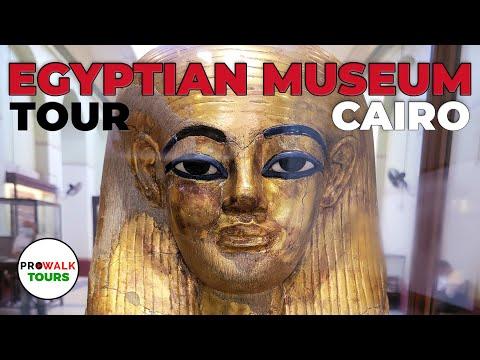As I stepped into the Egyptian Museum in Cairo, I felt a rush of excitement. The grandeur of the building and its rich history made it clear that this was not just a museum; it was a portal to the past, offering a glimpse into a world long gone. The façade of the museum, with its classic architecture and imposing columns, set the stage for what was to come.
The moment I entered, I was greeted by the cool air inside, a welcome contrast to the scorching Egyptian sun. The museum’s vast interior was filled with artifacts that spanned millennia, and I was eager to dive into this treasure trove of ancient wonders. My guide, a knowledgeable and enthusiastic historian, was ready to lead us through the maze of exhibits, each one telling a story of its own.
Our journey began in the central hall, where the sheer scale of the collection was overwhelming. I was immediately drawn to a display case housing an intricately designed sarcophagus. The craftsmanship was extraordinary, and I could almost imagine the artisans painstakingly creating this masterpiece centuries ago. The sarcophagus belonged to a high-ranking official, and the guide explained the significance of the hieroglyphs that adorned it. Each symbol told a part of the individual’s life story, beliefs, and status in society.
Moving on, we entered the Tutankhamun exhibit, which was nothing short of breathtaking. Seeing the golden mask of Tutankhamun up close was a surreal experience. The mask, with its detailed inlays and mesmerizing colors, radiated the opulence of ancient Egypt. I learned that this mask, discovered in 1922 by Howard Carter, was one of the most iconic symbols of ancient Egyptian civilization. The exhibit also featured Tutankhamun’s other treasures—his chariots, weaponry, and even his throne. It was as if we were walking through a royal tomb, uncovering the splendor of a young pharaoh’s final resting place.
The guide led us next to the mummification room, where the process of preserving bodies for the afterlife was explained in detail. I found it fascinating how the ancient Egyptians believed in a life beyond death and went to such lengths to prepare for it. The elaborate techniques used to preserve the bodies, from the removal of internal organs to the wrapping of linen, highlighted their deep spiritual beliefs. The room also featured various tools used in the mummification process, each one meticulously crafted to aid in the preservation of the deceased.
As we continued our tour, we reached the section dedicated to ancient Egyptian art. The sculptures and statues here were remarkable. One particular piece that caught my eye was a colossal statue of Ramses II, who was known for his military prowess and extensive building projects. The statue depicted him in a powerful stance, with a commanding expression that conveyed both strength and authority. The attention to detail in the carving was impressive, from the intricate folds of his robes to the regal headdress.
The museum also had a fascinating section on everyday life in ancient Egypt. Here, we saw artifacts such as pottery, jewelry, and tools that illustrated the daily activities of ordinary Egyptians. One display featured a collection of beautifully decorated amulets and charms that were believed to bring protection and good fortune. It was intriguing to see how deeply intertwined religion and daily life were for the ancient Egyptians.
One of the most memorable parts of the tour was the chance to see the Rosetta Stone. Although I had read about it in textbooks, seeing it in person was an awe-inspiring experience. The stone, inscribed with a decree issued in 196 BC, was key to deciphering Egyptian hieroglyphs. It was amazing to think that this single artifact had unlocked the secrets of an ancient civilization, enabling us to understand their language and culture.
The museum’s collection also included a variety of papyrus scrolls and ancient manuscripts. These texts offered insight into the intellectual and literary achievements of the ancient Egyptians. I marveled at the well-preserved writings, which included religious hymns, medical texts, and historical records. Each scroll was a testament to the advanced knowledge and sophisticated society that thrived along the Nile.
As the tour drew to a close, I couldn’t help but feel a deep sense of appreciation for the history and culture I had just encountered. The Egyptian Museum in Cairo was more than just a place to view artifacts; it was a journey through time, offering a tangible connection to one of the world’s most fascinating civilizations. Walking through its halls, I gained a newfound respect for the ingenuity and artistry of the ancient Egyptians. Their legacy, preserved in this remarkable museum, was a powerful reminder of the enduring human spirit and our quest to understand the world and ourselves.
